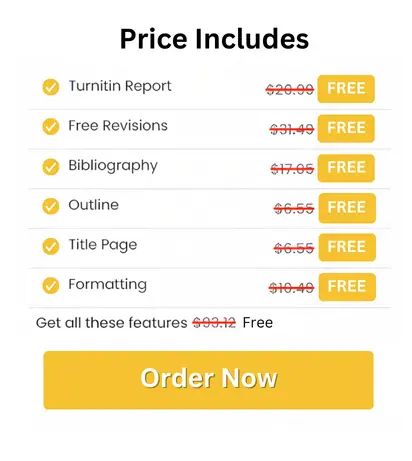
OB223 Organisational Behaviour Report Sample
Assignment Structure
Questions:
Refer this case study -Agribusiness Pioneer Pty Ltd
Based on the scenario given , you are required to provide a written report (maximum 1750 words) addressing the following 4 questions:
- What are the advantages of teamwork and team building, how would it support job performance? Recommend team style/s that would be required for this success?
- Should there be a consideration for a new job design, better goal setting and working conditions.
- How can the organisation better motivate and empower its staff towards helping them achieve the mission and vision?
- What can the management team do to provide more support and help employees feel more involved and part of the entire organisation?
You are required to use your learning from this unit and support your decisions with literature (minimum 5 articles) outlining what actions need to be undertaken and their benefit that may be perceived. It would be beneficial if you provide a time frame for implementation of your recommendations too. Read your Assessment Rubric to understand minimum requirements.
Use your theories from Organisational Behaviour to understand the organisation and recommend suitable changes to ensure that the company can achieve it mission and vision.
Your report needs to be structured with the following:
- Times New Roman 12pt font to be used
- Cover Page (List your student name, student number, unit name, unit code, lecturer name)
- Contents
- Executive Summary
- Introduction
- Discussion
- Conclusion
- References (must be APA style)
Solution
Introduction
Agribusiness Pioneer Pty Ltd is a consulting leader in the agribusiness sector and is at a turning point, aspiring to grow influence beyond Queensland and into the national and international markets. High employee turnover and very low job satisfaction rates have prevented this transition from occurring. The elimination of this problem is key to maximizing the benefit of the skills brought to the company by its current employees and for the sake of sustainability. Presented in the next report are comprehensive approaches around redesigning job roles, enhancing alignment of goals, improvement of working conditions, and development of the culture of recognition and empowerment that would provide the motivational, engaging, and retaining opportunities for staff, in line with the ambitious growth of the company for university assignment help.
1. Advantages of Teamwork and Team Building, and Their Support for Job Performance
Teamwork and team building are very critical components for the improved performance of a job in almost every kind of organization, including Agribusiness Pioneer Pty Ltd. The benefits and strategic implementation of teamwork can be systematically outlined under a few headings:
• Advantages of Teamwork and Team Building
Better Problem-Solving: Diversity in a team brings about different perspectives, hence better solutions devised that are creative and innovative. Employees of different backgrounds and expertise come together and, most of the time, are best suited to solve problems in the most effective and innovative way (Matsumoto & Gopal, 2019, p. 250).
Increased Morale and Engagement: Team building activities are an important platform to develop good relationships and trust among the team members. When team members feel connected and appreciated, their engagement to work goes up, affecting productivity and overall happiness at the workplace (Walsh et al., 2019, p. 1038). The activities break down barriers at the workplace and also boost the morale of the employees, leading to high job satisfaction.
Efficiency: A well-coordinated team makes maximum use of available resources and skills. Teammates acting together can perform certain duties more effectively and efficiently than if they worked alone. This not only quickens the completion of a project but also enhances quality, as works are dealt with by team members playing to their strengths Walsh et al., 2019, p. 1039).
• Support for Job Performance
Collaboration: Effective communication within the team is an important foundation for handling workloads and optimizing the delegation of tasks. Teams that are great at communicating ensure that everyone understands what they are doing, resulting in smoother project execution and higher productivity
Innovation: Teams generally come up with a lot more creative ideas than an individual. Working together in such an environment, people can exchange ideas freely, and are encouraged and valued for their creativity (Narzary & Palo, 2020, p. 1438). This would particularly benefit companies like Agribusiness Pioneer Pty Ltd that aims for innovation and to be at the front.
• Recommended Team Styles
Cross-functional Teams: A team of people from diversified functional departments who work toward complex projects. They form the base for innovation, doing so by holistically solving problems, and remove the silos that are created within an organization, thus making operations more integrated and efficient (Narzary & Palo, 2020, p. 1439).
Self-managed Teams: Entrusting the authority to take decisions with the teams goes a long way in motivating them to be more accountable. Empowered team members feel responsible for the success of the project, aligning their goals with those of the organization, and leading to a responsible and ownership-oriented culture
• Timeframe for Implementation
These team strategies should be implemented from the next quarter itself, with a primary focus at the outset on team-building exercises and an infusion of cross-functional and self-managed teams. The periodic reviews, every quarter, will facilitate the evaluation of such strategies and any necessary adaptation to optimize team performance and morale (Masykuroh & Muafi, 2021, p. 10).
2. Consideration for New Job Design, Better Goal Setting, and Working Conditions
Key strategies that can make employee satisfaction and productivity at Agribusiness Pioneer Pty Ltd higher include job role redesign, more realistic goal setting, and better work environment. Implementation of such changes should be considered thoroughly in the way that may increase the overall efficiency of the firm and at the same time allow the workers to feel happy about their job.
• New Job Design
Involving more decision-making and creative tasks as added to the jobs, it is possible to have more job depth through job enrichment. This results in the further interest and involvement in the work by the employees as they gain better control and ownership of the tasks. This can enhance satisfaction amongst employees, and as a result lead to reduced turnover. Employees who derive some meaning in their work are likely to continue being committed to the organization.
Role Clarity: Role clarity is very important in making sure that the roles and responsibilities of employees are defined in the clearest way possible, reducing ambiguity and confusion in work. This allows employees to understand their tasks and how their work relates to the wider objectives of the organization. When employees realize the significance of their roles within the bigger company context, it boosts their motivation and efficiency
• Better Goal Setting
SMART Goals: Specific, Measurable, Achievable, Relevant, and Time-bound. On the basis of these, employees will clearly understand what is expected of them as a result of these set targets. SMART goals provide a framework within which direction can be given to the efforts of employees for enhanced productivity and to make sure that personal achievements are in tandem with the company goals.
Align Goals with Corporate Objectives: Performance goals of the individual should be clearly defined in a measurable and specific sense, but they should be related to corporate strategic goals. Such an alignment will make the efforts put in by each employee count directly toward the company's success, thereby fostering a singular sense of direction across all departments, underlining the relevance of each employee's role in achieving corporate objectives.
• Improved Working Conditions
Ergonomic Workspaces: Investments in an ergonomic design of workplaces improve the physical well-being of the employee, which directly relates to enhanced productivity and reduced workplace injuries. Comfortable working conditions are a basis of employee care, which reveals the company's commitment to the safety and health of its workforce..
Flexible Work Arrangements: Flexible scheduling and options to work remotely should be provided to employees. The flexibility in scheduling and remote work emerges as the key elements of the arrangement that were most valued by workers with personal responsibilities. They also increase retention and satisfaction with jobs
• Timeframe for Implementation
The changes, therefore, will be put in place within the next six months to ensure that the transitional phases are realized without any hitches in their coordination with the company's activities. The first review will be after three months to test how effective the changes are for adjustment to be made where they are needed. This time will also enable the workers to adjust to their new environment and therefore give feedback on the changes
3. Motivating and Empowering Staff to Achieve Mission and Vision
The strategies have to be developed to implement proper motivation and empowerment that is in line with the mission and vision of Agribusiness Pioneer Pty Ltd. The company should develop a culture of recognition, professional growth, participative decision-making, and autonomy among staff members. An enabled implementation would drive higher engagement and innovation, thereby getting the organization nearer to the goals.
• Motivation Strategies
Recognition Programs: A big help would be those employee recognition programs put into place to bring to light and reward exemplary performance. Such programs increase morale, providing positive reinforcement for the behaviors and results congruent with the values and goals of the company. Announcing the achievement publicly can motivate the recipient and communicate a benchmark of success to challenge others to greater heights. Some examples could be monetary bonuses, public recognition, further advancement in their career, or any other valued experiences that show appreciation (Matsumoto & Gopal, 2019, p. 252).
Career Development: A chain of development and training opportunities is a must for the growth of any individual, both at a personal and professional level. If employees feel that the organization is interested in their skills and future development, they get more loyal and motivated to contribute effectively (Palsodkar et al., 2023, p. 568). The programs of development should be tailor-made to help an employee in the path towards the realization of career goals, besides meeting the needs of the company, thus creating a win-win growth situation. This, in turn, not only retains talent but also ensures that the workforce evolves in line with industry standards and innovations.
• Empowerment Strategies
Participative decision-making: The involvement of workers in the decision-making process not only imbues them with a feeling of greater control over work-related matters, but also results in increased commitment toward the outcomes. If workers feel that their views are important, they will be more likely to take initiative and behave with more accountability (Palsodkar et al., 2023, p. 570). This could take the shape of frequent brainstorming sessions, the planning stages of projects, and mechanisms that produce feedback and allow workers to influence policies and procedures.
Autonomy: Employees should be allowed to work with full autonomy to inculcate as much responsibility as possible and encourage them to be innovative and take the initiative. Autonomy, to a certain extent, breeds a sense of responsibility that will bring about a big change in job satisfaction and performance (Zhou et al., 2022, p. 569). This shall work well, especially for jobs that require creativity and a problem-solving attitude, where too much structuring may hinder the potential of innovative solutions.
• Timeframe for Implementation
Implementation of these motivation and empowerment approaches should be within the coming three months. This should give the company a quarter period for preparation and implementing the initial stages of the recognition programs and the participative decision-making programs. To customize these programs to fit the employees, the company will have an opportunity to involve the employees at the early stages of planning so that the system becomes effective and relevant to the strategic goals of the company.
4. Support from Management to Increase Employee Involvement
Integrating open communication and involving the employee in the decision-making processes comprehensively requires support in the management structure (Judith & Diana, 2023, p. 765). This will set the foundation for a working environment in which the employee is recognized as a crucial ingredient in the success of the organization.
• Strategies for Management Support Continuous Feedback
Continuous feedback methodology should be implemented. This creates an avenue for the manager and the staff to discuss job performance and expectations regularly. Regular feedback sessions help make sure that various issues are avoided and a continuous communication process is fostered between a supervisor and his staff (Judith & Diana, 2023, p. 767). It should be properly structured but also flexible enough to allow both formal reviews and informal check-ins, keeping an open line of communication for immediate improvements and on-the-spot acknowledgment of good performance.
Open lines of communication: It is very important to develop a culture within which the employee feels free to raise his concerns, suggestions, and feedback. Open communication channels are a means of implementing transparency within an organizational culture where inputs from the employees will be valued and believed in (Masykuroh & Muafi, 2021, p. 5). This openness can be supported through tools such as internal forums, suggestion boxes, and regular Q&A sessions with the top leadership, so that every employee feels empowered and therefore feels free to share their insights and concerns.
• Involvement Strategies
Town Hall Meetings: The arrangement of regular town hall meetings is another way to make sure all employees are aligned with strategies and updates of their respective companies. Let these meetings be interactive; allow every employee to ask questions and bring feedback to the table where top management is present. Town hall meetings create a platform for leadership to cascade important company news and for the employees to feel involved with the bigger business context, hence connecting even deeper with the goals and missions of the company.
Involvement in decision making: By having employees participate in strategy sessions and making decisions, especially those that affect their work, their sense of involvement and satisfaction can easily be increased. If the employees are involved, then they are more likely to grasp and be committed to the direction that the firm takes since they have been involved in shaping that direction. This approach should be implemented in a way that shows respect for the expertise and perspective of different members of the team, leveraging their knowledge to achieve a better, more informed final decision.
• Timeframe for Implementation
New communication lines and feedback systems can be started in the next two months so that necessary infrastructures can be put in place to train the managers and staff with the tools' usage. Town hall meetings can be scheduled within the first month; the earlier the better to create momentum that maintains regularity. This is important for creating immediate momentum and to start integrating these practices into the very culture of the company.
Conclusion
The strategies laid out in this report aim at reviving Agribusiness Pioneer Pty Ltd by addressing core issues related to employee engagement and job satisfaction. Strategies for the achievement of enriched job roles, goal clarity, improved workplace conditions, recognition for employee achievements, opportunities for professional development, and the support of strong management, respectively, are put in place. The implementation of the strategies will not only cut down employee turnover but, most importantly, build a very resilient and innovative workforce driving the company closer to its ambitious vision. Therefore, regular reviews and necessary modifications of these strategies will take place to keep them on the run and updated with the current needs and expectations from the employees.
References
Judith, K., & Diana, T. (2023). Integrating Employee Feedback into the Continuous Improvement of Performance Management. Revista de Management Comparat Interna?ional, 24(3). https://doi.org/10.24818/rmci.2023.5.760
Masykuroh, N. L., & Muafi, M. (2021). The influence of job insecurity and person-job fit on turnover intention mediated by job satisfaction. International Journal of Business Ecosystem & Strategy (2687-2293), 3(3), 01-12. https://doi.org/10.36096/ijbes.v3i3.271
Matsumoto, M., & Gopal, B. (2019). Solidarity, job satisfaction, and turnover intent in employees. International Journal of Workplace Health Management, 12(4), 247–257. https://doi.org/10.1108/ijwhm-09-2018-0118
Narzary, G., & Palo, S. (2020). Structural empowerment and organisational citizenship behaviour. Personnel Review, ahead-of-print(ahead-of-print). https://doi.org/10.1108/pr-11-2019-0632
Palsodkar, M., Yadav, G., & Nagare, M. (2023). An agile new product development-based sustainable supply chain framework to improve environmental quality performance: emerging economies perspective. Management of Environmental Quality: An International Journal, 34(3), 565–588. https://doi.org/10.1108/meq-04-2022-0119
Walsh, G., Yang, Z., Dahling, J., Schaarschmidt, M., & Takahashi, I. (2019). Effects of service employees’ negative personality traits on emotional labour and job satisfaction. Management Decision, 58(6). https://doi.org/10.1108/md-11-2018-1206
Zhou, Q., Mao, J.-Y., Xiang, S., Huang, R., & Liu, B. (2022). How can leaders help? A mediated moderation influence of leader consideration and structure initiation on employee learning from work failures. Journal of Knowledge Management, 27(3)




 81 Isla Avenue Glenroy, Mel, VIC, 3046 AU
81 Isla Avenue Glenroy, Mel, VIC, 3046 AU



